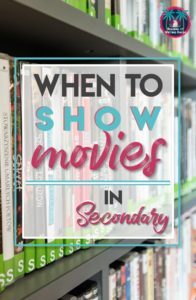Movies in School: Using them Meaningfully
We’re all familiar with the stereotype of the burnt out teacher. Mrs. Jones is so exasperated with her students and her job that she has completely given up. Instead of teaching, she shows movies. Unfortunately, this stereotype has somewhat tainted people’s opinions of the usefulness of films. Showing movies in school can be meaningful. It can also be an activity that promotes learning. But how?
Welcome to ELA Today, a monthly chat where the authors of Reading and Writing Haven and Language Arts Classroom cover different ways of approaching common decisions in the ELA classroom.
Movies are not inherently evil. In fact, they are visual texts. Students should be taught to comprehend, analyze, and discuss a movie just like any other piece of fiction or nonfiction. Showing movies in school can be powerful. The list of possibilities for their use is countless. In this post, I’m suggesting a handful of ways teachers can use movies to improve teaching.
Use movies to scaffold understanding of complex texts.
I always use movies to support students’ understanding of Shakespeare’s plays and other rigorous texts that contain cultural context students might not understand. Every year, I use film versions of Romeo and Juliet and The Odyssey to frame students’ understanding of the story.
Using a visual format is beneficial for all levels of learners. My advanced students read the whole text, but we also compare and contrast different versions of the films. On the flip side, my struggling students use the film to supplement since we do close readings with the most important portions of the stories but don’t read the entire text.
I used to think I wasn’t a good teacher if I didn’t have students read every page of the story, but over the years, I’ve learned that I am actually a better teacher for using film to enhance and scaffold comprehension. Videos appeal to the visualization element that is so necessary to understand complex texts.
Use movies to develop analytical thinking.
I like using movies as writing prompts because students often care about the topic. To introduce literary analysis, I have students analyze the theme of a short film. Sometimes, I pair the short films with poetry to make for meaningful paired text practice.
I’ve also asked students to watch a movie of their choice and analyze the cultural elements of the film. For example, I model with the movie Gladiator for my high school students. We watch the film, and then we explore the statements the movie makes about culture, counterculture, stereotypes, and more. Students always enjoy this activity, but it pushes them out of their comfort zones. There’s nothing easy about it.
When I teach fairy tales, I enjoy asking students to analyze the movie Brave. Is it an original fairy tale, or is a combination of old stories already in existence? Similarly, Mr. Peabody and Sherman is a fun one to analyze genres and complex character development.
Use movies to teach life skills.
Sometimes, students need to be able to analyze a movie to understand important concepts about life. Part of our job as educators is to embrace the whole student. Movies like Wonder are amazing for helping students to see the importance of kindness and compassion. Zootopia is perfect for teaching students perseverance and determination.
Helping students to understand different lenses through which they can view life is also important. During my critical reading lenses unit, I try to incorporate a visual text for each lens: feminism, multicultural, and socioeconomic. Many Disney movies, like Cinderella, Mulan, and Aladdin work well. As they watch, students are encouraged to think about how someone who views life from a different lens might interpret the film. These lessons not only encourage critical thinking but also teach empathy.
Use movies as pre-reading activities.
Before reading a Shakespearean play (especially Romeo and Juliet or Hamlet), I show students The Lion King. This film features almost every literary term I cover in the reading unit. By introducing students to the terms in a familiar context, they have a better grip on malapropisms, irony, and figurative language when we encounter them in the Bard’s plays.
Before reading To Kill a Mockingbird, it’s important that I introduce students to key concepts – like racism, discrimination, and stereotyping. One quick way to do this is to hold a class discussion about those terms in order to get a glimpse of prior understanding. Following that discussion, we watch The Sneetches. As we watch, students answer critical thinking questions that we later discuss as a class.
These pre-reading activities get students excited about the text and also help to build prior knowledge in order to scaffold their understanding of central ideas and key terms.
I could go on…
I’ve experimented with movies in so many different formats, but the most important takeaway I have from my experiences is that movies should only be used in meaningful contexts. That teacher who shows movies because she’s tired and cranky? She gives films a bad rap. Movies can and should be meaningful. Teachers can engage twenty-first century students with visual texts that are relevant. Movies can be used to enhance lessons, scaffold understanding, and make learning memorable.
And remember…
Make sure to ask questions about your school’s movie policy before showing any films in class. Are you expected to send home permission slips? Can you show the entire film, or just segments? Do you need to stick to G rated movies? Ask ahead of time so that you feel confident with your teaching decisions.
What’s your favorite way to use movies in the secondary classroom? We’d love to hear from you. As always, there is more than one way to teach ELA. If you’re looking for more inspiration, Language Arts Classroom has you covered. Here’s how she uses movies in the classroom.

